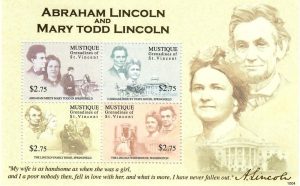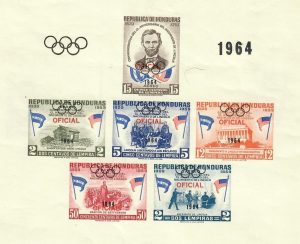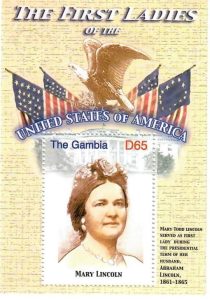Getting Right with Mary Todd Lincoln
 Getting Right with Mary Todd Lincoln
Getting Right with Mary Todd Lincoln
William D. Pederson
George and Martha, Abraham and Mary Todd, Franklin and Eleanor, Jack and Jackie, legendary First Couples so familiar to the public that their names blend into one. The near-universal recognition of Abraham and Mary Todd, the high profile Team Lincoln, includes the large number of books written about both Mary Todd and Abraham. In fact, Lincoln, who captured the presidency with considerable help from his politically savvy and ambitious spouse, is the subject of more books than any other democratic political leader in world history. Sharply contrasting how this early “power couple” is remembered in millions of written words is their philatelic legacy, their pictorial tributes on the ubiquitous postage stamp. Lincoln is one of the most prominent American presidents in philately; Mary Todd’s absence from postage stamps in North America, including the United States, is a notable contrast. This paper attempts to explain why Mary Todd has not been honored with even one postage stamp in North America, and it will review the change in perception about her, a dramatic shift that has occurred in recent decades.
Changing Historical Minds
After ratification in 1920 of the Nineteenth Amendment to the U.S. Constitution, women journalists and historians began to re-assess the traditional view of Mary Todd that had been chiseled onto the pages of history by male historians and perpetuated by subsequent male historians. They portrayed her unkindly as an additional burden for “Saint Abraham” to bear during the American Civil War. In the wake of Abraham’s assassination in her presence and her abrupt removal from the Executive Mansion, she was committed to an asylum by her only surviving son, an indelible social stigma. Her post-First Lady circumstances became fodder for sexist jokes at professional conferences—then exclusively male. Later, Hollywood movies magnified her situation on the big screen. The plight she faced as a widow especially underscored the U.S. Constitution’s silence about a role for the presidential spouse. Yet, in the next century Eleanor Roosevelt, another strong-willed First Lady, did not let the lack of constitutional definition prevent her from further transformation of that nebulous role into an important new one. She championed relief for Americans suffering from the Great Depression by using her voice and position to endorse her husband’s novel “New Deal” as an antidote to the impoverishment and subsequent social upheaval that wracked the nation. Considered the first modern president of the Twentieth Century, Franklin’s bold programs helped to secure his place in presidential history. Today, he consistently ranks among the top three presidents in polls of scholars. Eleanor is number one among First Ladies.
Her expansion of the First Lady’s role, co-commitment with the rise of the modern American female, was foundational for the belated fresh evaluation of Mary Todd that historians commenced beginning in the late 1980s and continued into the Twenty-first Century. As a result of revisions in the pre-existing assessment, Mary Todd was recast as a genuine role model for Eleanor Roosevelt, Jackie Kennedy and the First Ladies who followed them. Mary Todd’s considerable influence was reinforced by the conclusion of journalist and multi-volume biographer Sidney Blumenthal: without Mary Todd there would be no Abraham Lincoln.
Mary Todd Philately Abroad
Abraham Lincoln, the autodidactic frontiersman, talked about traveling abroad. He never did. Nonetheless, his enduring democratic imprint continues to be felt in every part of the world. Unlike her husband, Mary Todd traveled abroad. Like Jack Kennedy, Lincoln couldn’t speak French. Mary Todd, however, spoke French. And Jackie famously spoke it to adoring crowds on an official trip to France, prompting President Kennedy to quip that he was the man who accompanied Jackie Kennedy to France.
Lincoln never traveled beyond America’s borders, but his legacy did. There are stamps, schools and streets around the world that honor him. North America, Europe, the Middle East and Asia all have issued stamps honoring Abraham, but not Mary Todd. However, in Africa, the Caribbean and Pacific Islands, her image has appeared on stamps in nations that accord her the same honor as they have bestowed on Abraham.
Central America was the first to put Mary Todd on its stamps. In a scene depicting the assassination at Ford’s Theatre, a Honduran stamp shows her throwing her arms in the air in horror as her husband is shot. These airmail stamps were issued as part of an eleven-stamp series showing different scenes that were to commemorate the centennial of Lincoln’s presidency. They were re-issued twice. The first re-issue occurred in 1963, overprinted with the date of Kennedy’s assassination. In 1964 they were again re-issued during the Olympic games.

The revision of the historical verdict about her occurred in the 1960s, the fraught decade that separates the “old Mary Todd” as traditionally depicted by male historians from the more nuanced Mary Todd that emerged with the rise of female biographers. They came to see her as a victim, but did not limit her to a single dimension. Instead, they portrayed her as an equal in her marriage, the First Lady who did more in the Executive Mansion than any of her predecessors, and the pioneering First Lady who established the model for her successors.
During the turbulent ‘60s when there was global upheaval of status quo, so-called “third world” countries were challenging institutionalized colonialism and racism, and, to a lesser degree, sexism. That societal recalibration is reflected especially in “the new Mary Todd” featured on postage stamps abroad that originated from Africa to the Pacific Islands to the Caribbean during, as well as after, the bicentennial of Lincoln’s birth in 2009.
The best example from Africa comes from The Gambia in western sub-Sahara Africa, which gained independence from the British in 1965. Davida Jawaru became its first president as a republic (1970-1994) and set a Lincolnesque democratic precedent for The Gambia, unlike in many newly independent African nations. From that foundation, The Gambia became one of the most enduring democratic political cultures in Africa. In 2009, The Gambia set the precedent of issuing a series of stamps that featured consecutive First Ladies of the United States, similar to the U.S. presidential stamp series.
 A second series of First Lady stamps was launched in 2017 (Scott No. 3740). The most impressive stamps and souvenir sheet, however, was issued in 2015. The first of the four stamps in the souvenir sheet showed Mary with sons Robert and Tad. The stamps were acknowledgement of Mary’s international stature as former First Lady of the United States.
A second series of First Lady stamps was launched in 2017 (Scott No. 3740). The most impressive stamps and souvenir sheet, however, was issued in 2015. The first of the four stamps in the souvenir sheet showed Mary with sons Robert and Tad. The stamps were acknowledgement of Mary’s international stature as former First Lady of the United States.
The tribute to both parties in the Lincoln marriage next surfaced in the South Pacific during Lincoln’s Bicentennial. The souvenir sheet was an unprecedented attempt to portray a timeline of his life. The four stamps each show a portrait of Lincoln at different points in his life while the background on the souvenir sheet includes First Lady Mary Todd Lincoln in the upper right corner and notes the Lincolns marriage in 1842. In the lower right corner, Mary Todd is partly visible sitting next to Lincoln at Ford’s Theatre, a less dramatic assassination scene than appeared on the 1960 Honduran stamp.
Palau comprises hundreds of islands spread over three million square miles in the western Pacific Ocean, but only eight islands are inhabited. First a Spanish colony in 1710, it became a German colony in 1898, followed by Japanese control after World War I. After World War II, Palau was under U.S. administration through the United Nations Trusteeship. It became the Republic of Palau in 1980 and in 1994 became the last territory in the United Nations Trusteeship to achieve independence.
Located near Palau are more than six hundred islands, collectively the Federated States of Micronesia. Like Palau they once were a Spanish colony before becoming a German one in 1899, and then Japanese from World War I until 1947 when it became a trust colony of the United Nations and placed under U.S. administration. Full independence was finally achieved in 1991. Its 2010 souvenir sheet features four Lincoln stamps. One is a portrait of Lincoln delivering the Gettysburg Address and another shows him reading the Emancipation Proclamation. Also in the group, for the first time on a stamp Mary Todd and Abraham Lincoln photographs appear side by side. There are no known photographs of them together.
The most elaborate Mary Todd presentation on a stamp to date is from Latin America. It shows eight images of the couple together as well as a Lincoln quote praising Mary Todd. Mustique, a part of St. Vincent and the Grenadines, located in the middle of the Caribbean Islands, issued the stamps. St. Vincent is the largest island and about one hundred smaller islands make up the Grenadines. The British took over St. Vincent in the 1760s, the French in 1779 and the British again in 1783 until St. Vincent gained independence in 1979. These Lincoln stamps suggest the Lincolns were equals.

Conclusions
Just as the Old South had to “get right” with Abraham Lincoln, historians both North and South had to do the same with Mary Todd. To a large degree that was achieved in the biographies by Jean Baker, Catherine Clinton, and Stacy McDermott.
In short, Abraham and Mary Todd each learned from the other and they treated each other as equals well before the presidency. When he became president, Abraham insisted upon completion of the Capitol Dome as a symbol of American democracy. Similarly, Mary Todd insisted on transforming the Executive Mansion into a suitable residence for the president, another democratic symbol. However, back in Illinois, she had known that the first step on her journey to the Executive Mansion was to insist on transforming her backwoods spouse to make him presentable in public.
William Pederson is Professor of Political Science and the American Studies Endowed Chair at Louisiana State University at Shreveport.
Bibliography:
Sidney Blumenthal, A Self-Made Man: The Political Life of Abraham
Lincoln. (New York: Simon & Schuster, 2016).
William D. Pederson, “Mary Todd Lincoln,” in Katherine A. Sibley, ed. A
Companion to First Ladies (John Wiley, 2016), pp. 214-229.
